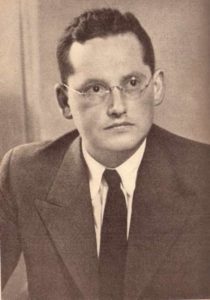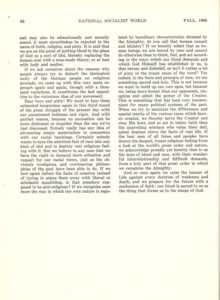
Please see the introduction to this and other articles by Prof. Dr. Walter Groß which can be viewed here. That page gives a more detailed reference to this pieces.
Heilig ist das Blut (Blood is Holy) by Prof. Dr. Walter Groß, August 7th 1935.
Heilig ist das Blut (Blood is Holy) is a radio speech aimed at the youth given on August 7th 1935. [Source: Heilig ist das Blut. Eine Rundfunkrede von Dr. Groß (Berlin: Rassenpolitisches Amt der NSDAP, 1935).]
Dear German Boys and Girls!
As we talk about blood and race this evening, we are discussing a theme that is in the center of today’s intellectual and worldview battles. You all know that those who oppose our movement for political or worldview reasons have been forced more and more over time to grant the political and economic achievements of National Socialism. They can no longer be denied even by the most hostile critic. As soon as the discussion turns to National Socialism’s intellectual foundations, however, as soon as the idea itself is debated upon which everything we do is based, there are objections. And as in the past, National Socialism’s racial thinking is called into question or openly opposed. We see that if we survey the world press, as well as in discussions with groups within the country who still believe that they can reject individual aspects of the National Socialist worldview.
I have previously spoken about what we mean by racial thinking in the broad sense [Editor: see Rasse (Race) by Dr. Groß, October 10th 1934, above]. I said then that the doctrine of blood and race for us is not primarily an important and interesting part of biological thinking, but rather above all a political and worldview attitude that determines our fundamental approach to many aspects of life. The two most important facts underlying this approach are the knowledge of the power of inheritance and the knowledge of the deep and spiritual significance of racial differences within humanity. Since we realize our dependence on inherited characteristics, we do not fall prey to the old error of overestimating outward influences of education, training, and welfare policies. We realize the responsibility for passing on our own genetic material, since from it alone will flow the strength of the future. We are therefore humble about our own accomplishments, for they have their roots in what we received from our ancestors without any effort on our own part, yet we are also proud that our own brief lives are links in the chain of generations. We are a bridge from the greatness of the past to the most distant future.
Since we have learned to recognize and respect the physical and intellectual characteristics of the earth’s various races, we are free of the sick desire that sees no differences, or seeks to make everything the same in the political, cultural, and religious realms. We are conscious once again of our characteristics and want to care for and protect them because they are the natural way for us to live as a people and a nation. At the same time, we respect the characteristics of the earth’s other races, since we no longer want to subordinate them or force them to accept our ways of thinking and feeling as we once did, but are instead convinced that they, too, should live and act according to the laws of their blood.
That is in brief the content of the racial thinking that we teach and learn. We might ask why this simple, yet powerful idea causes so much conflict. If we examine the matter, we will find that the reasons for its rejection have often varied over time. The opponents of our racial doctrines have been consistent in rejecting new thinking, but they regularly changed the battlefield on which they tried to fight us, and have thereby forced us to deal with and defend this question from various perspectives.
When one first dared to speak of race many years ago during the rotten era of liberal bourgeois thinking and Marxist corruption, people responded to the dangerous new thinking on so-called scientific grounds. They rejected our genetic knowledge and ridiculed racial science and its proponents, announcing from pulpits, editorial offices, and meeting halls that they were dealing only with the fantasies of a handful of ignorant fools. It is good to remember those days, to recall the nasty tactics of the opponents of our worldview. There were then serious and learned scientists who were working out a new way of looking at the world, and others over many years used every means to attack their honor and trample them down, despite all the cries about the freedom of science — because that is what the rulers of the day wanted.
Happily, that is behind us. Those in every camp and in every country around the world have realized that the scientific basis of our racial thinking is no longer in doubt. Serious scientific discussion in this area concerns only the extension of our thinking in particular areas, no longer the scientific validity of the fundamental principles. Science has become quieter about the matter, which means that the opponents of our worldview must find new ways to defend their old values against a new age. Soon they found a new slogan for the battle: one took to the field against us in the name of humanity, ethics, and morality. The scientific foundations could no longer be disputed, but they had great and unacceptable effects in the life of the nation. You know the kinds of things thrown at us in recent months: the idea of inheritance, for example, was suddenly dangerous since it removed individual responsibility for one’s actions and gave everyone an excuse to be lazy, bad, or depraved, since those things were the results of one’s inheritance. Worried aunties of both sexes wrung their hands and saw an approaching era without discipline or conscience, and thought that they could blame the false teachings of National Socialist racial doctrine. We took on that battle, and can probably say that we have already won it. Such charges against our views are simply untrue, nothing but a nasty trick. In any event, we are not the masters of our own fate, since we are always dependent on what we have inherited, on what Heaven has given or denied to us. That does not mean that we or others have nothing to do, or that education is unneeded. The opposite: What we do, whether for good or will, with our inherited characteristics is our own responsibility. We can squander and waste our abilities, or we can develop and use them. We can be lazy and allow what is weak or bad in us to grow, or we can bravely fight our whole life against them. That is the decision that each of us must make, and we demand that each individual realizes the great and difficult doctrine of responsibility alongside the knowledge of the inherited nature of our character.
That is a clear, understandable attitude, and before it all the objections of our opponents have gradually given way. Against their will, they must today grant the moral justice of our position, just as they had to do with its scientific correctness earlier. Recently, they have had to surrender their second line of defense as they continue to retreat. But now the old battle continues in a new, and to be honest, more important arena. Recently, arguments have been increasing that although National Socialism’s racial doctrines are correct, and that they may be defended on pedagogic and moral grounds, they still have to be rejected in the name of faith, religion, and piety. After all, some people mutter, one is replacing God with the idol of blood, putting a human theory or material things in the place of the eternal strength of the spirit.
If we look into the reasons why people from religious standpoints are still trying to oppose the united worldview of the German people, we find a thousand variations of this point, which is used as the last defense against the movement’s victorious idea.
Dear boys and girls! In this third area of conflict, we want to continue the great battle of our day with the old fighting spirit we used against the dark forces of the past. We have a right to do so, for no objection could be more dishonest or foolish than this one. No one in the name of racial doctrine supports barren materialism. No one wants to turn the facts about race into an idol and use it to destroy genuine piety. We do, however, believe that we have a right to have more respect for our racial worldview than was allowed by the impious and arrogant philosophies of the past. If we bow once more before the facts of creation instead of preferring empty liberal or scholastic chatter, how is that impious? If we are once more conscious of our own nature, of the inheritance given to us from Heaven, is that human arrogance or idolatry? If we once again humbly understand that our lives as humans are bound by our race, and that we can do nothing other than follow and act according to the laws of blood that God himself has placed us under, how can that be heresy or impiety? Is it is not in fact greater piety, and in the most genuine and truest form? Yes, we see in the facts and laws of race as something holy and divine, not because we want to promote ourselves, but rather because we also see there the power of the creator. We are more honest than our enemies, who found in them something uncomfortable for the previous system of political power. If we seek to respect the differences and particular virtues of the races that Heaven itself created, we thereby serve the Creator and his laws. We do a more pious work than the squabbling scribes whose gray dogma is more important to them than real blood-filled life. The best in every people and throughout all time have drawn their deepest and truest faith from observing the world’s order. With both pride and humility, we affirm that we see the laws of blood and race with their wonderful relationships and heavy burdens, as a holy part of that great order behind which we sense the Creator.
Today we once again raise anew the flag of life against the doctrine of death, and serve the future with the faithful affirmation: The blood given to us by God is holy.
(Source)
A slightly different translation appeared in National Socialist World, Number 2, Fall 1966. pp. 34-36 and can be viewed below – click images to enlarge. PDF here.
.


